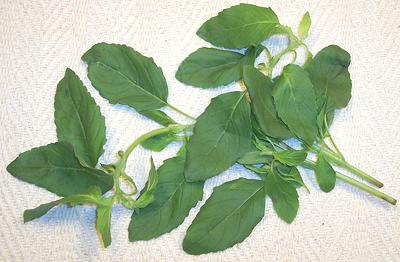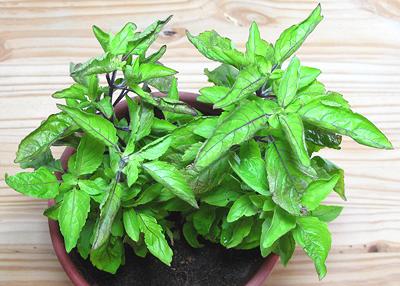Holy Basil / Tulsi
[Tulsi, Tulasi (india); Surasa (Sanskrit); Krapao (Thai); Hot Basil,
Humong Basil (California Markets); O. tenuiflorum alt
Ocimum sanctum (Mint family)]
In India Holy basils are highly revered, used for religious purposes and in
Ayurvedic medicine. In Southeast Asia they are used as a culinary herb.
Terminology is confusing as "Ram", "Rama" are applied seemingly at
random for Green leaf and Purple varieties, though those with deep purple
leaves are usually called Krishna Holy Basil. Unlike other basils the leaf
margins can be strongly serrated, the leaves slightly fuzzy and the stems
definitely fuzzy. Unlike other basils,they are always cooked. They have
very poor keeping qualities.
Holy Basil, Green / White / Ram
 While a sacred herb and used in Ayurvedic medicine in India, this is the most
used variety for culinary purposes in Southeast Asia. While very scarce in
markets due to perishability, seeds are easy to purchase for growing it at
home.
While a sacred herb and used in Ayurvedic medicine in India, this is the most
used variety for culinary purposes in Southeast Asia. While very scarce in
markets due to perishability, seeds are easy to purchase for growing it at
home.
Holy Basil, Purple Stem / Rama
 This variety seems preferred for Ayurvedic and therapeutic purposes in India.
This variety is also used for cooking in Southeast Asia, but not as much as
the Green variety. The flavor of this variety is a bit stronger than the Green.
Seeds are easily available in North America, and sometimes live plants, due to
interest in Indian Ayurvedic medicine.
This variety seems preferred for Ayurvedic and therapeutic purposes in India.
This variety is also used for cooking in Southeast Asia, but not as much as
the Green variety. The flavor of this variety is a bit stronger than the Green.
Seeds are easily available in North America, and sometimes live plants, due to
interest in Indian Ayurvedic medicine.
More on Basils.
Buying:
Holy Basil, sometimes called "Hot Basil" or
"Humong Basil" here in Los Angeles, can occasionally be found in markets
serving an active Southeast Asian community. It is highly perishable, so
it is often already wilted in the market. Used right away this is not a
problem because it'll be wilted in cooking anyway. It is best if you can
get it at a farmers market, from a grower who specializes in Asian herbs.
Of course, you can grow it yourself.
Storing:
If very fresh and loosely bagged in plastic,
this basil will keep 2 to 3 days in the fridge. If you buy it at a market
you'll be lucky if it lasts long enough to get it home. If the leaves are
only a little wilted you can refresh it somewhat by cutting the stem ends
off and immersing the whole bunch completely in cold water for an hour,
then dry in your salad spinner.
Substitutes:
A number of substitutes have been proposed,
including a mix of Thai Purple Basil and Mint or Perilla.
Cooking:
Unlike other basils which are used mostly raw
or just warmed as a garnish, Holy Basil is always used cooked, generally
added early in the cooking process. In Thailand it is often an ingredient
in stir fries, and also used in Vietnam, Laos, Malaysia, and Cambodia.
mt_basilhz 090524 r 250210 - www.clovegarden.com
©Andrew Grygus - agryg@clovegaden.com - Photos on this
page not otherwise credited are © cg1 -
Linking to and non-commercial use of this page permitted
 While a sacred herb and used in Ayurvedic medicine in India, this is the most
used variety for culinary purposes in Southeast Asia. While very scarce in
markets due to perishability, seeds are easy to purchase for growing it at
home.
While a sacred herb and used in Ayurvedic medicine in India, this is the most
used variety for culinary purposes in Southeast Asia. While very scarce in
markets due to perishability, seeds are easy to purchase for growing it at
home.
 While a sacred herb and used in Ayurvedic medicine in India, this is the most
used variety for culinary purposes in Southeast Asia. While very scarce in
markets due to perishability, seeds are easy to purchase for growing it at
home.
While a sacred herb and used in Ayurvedic medicine in India, this is the most
used variety for culinary purposes in Southeast Asia. While very scarce in
markets due to perishability, seeds are easy to purchase for growing it at
home.
 This variety seems preferred for Ayurvedic and therapeutic purposes in India.
This variety is also used for cooking in Southeast Asia, but not as much as
the Green variety. The flavor of this variety is a bit stronger than the Green.
Seeds are easily available in North America, and sometimes live plants, due to
interest in Indian Ayurvedic medicine.
This variety seems preferred for Ayurvedic and therapeutic purposes in India.
This variety is also used for cooking in Southeast Asia, but not as much as
the Green variety. The flavor of this variety is a bit stronger than the Green.
Seeds are easily available in North America, and sometimes live plants, due to
interest in Indian Ayurvedic medicine.